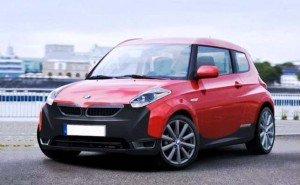
BMW has formed a new joint venture aimed at producing future "Megacity Vehicles," like this high-mileage concept.
BMW has formed a joint venture with SGL Group aimed at developing and producing carbon fiber, a strong yet super-light material that the German automaker plans to use to build its so-called Megacity Vehicle.
Key to the $133 million venture is transforming carbon fiber from a high-cost specialty material used only in the most expensive, limited-volume supercars and making it competitively priced for mass market products, the new partners noted.
BMW announced the Megacity project at its annual meeting, last March. Targeted for production sometime during the first half of the next decade, CEO Norbert Reithofer described it as “the first of a range of near-zero emission vehicles.” Also known as project-i, Reithofer said the Megacity program would produce both electric vehicles and those with highly efficient internal combustion engines.
The first Megacity Vehicle is the battery-powered Mini-E prototype, of which BMW is currently planning to build and field test 500. Eventually, such models could show up in the various BMW AG brands, including not only Mini but also BMW and possibly even Rolls-Royce. Reithofer ruled out adding a new brand to the group.
A challenge to that goal is reducing vehicle weight while maintaining the strength and integrity needed to meet modern safety standards. Reducing weight improves mileage in a conventional automobile, but it’s especially important when using battery power, since the lighter the vehicle, the better the range.
The carbon fiber joint venture will create two new companies, one based in Germany, the other in the U.S., with SGL holding a 51% share, BMW 49%. The raw materials, according to plans, will be produced in North America, with the fabric woven into body structures in Germany. A total of 180 new jobs are to be created, the partners said.
“This joint venture with the BMW Group is a milestone for the use of carbon fibers on an industrial scale in the automobile industry,” said Robert Koehler, CEO of the SGL Group.
Currently, the material is only applicable to use in vehicles where cost is a relatively low concern, such as the new, $375,000 Lexus LF-A supercar, which uses a carbon fiber-reinforced plastic for the majority of its chassis and body shell.
But with the new joint venture, said Koehler, “For the first time, carbon fibers are taking on an important role in series vehicle manufacture. This confirms our strategy and shows that carbon fibre technology is becoming increasingly important in the materials substitution process to lighter material. This material will help to reduce CO2 emissions and save our natural resources.”
Analysts say several critical steps will be needed to make carbon fiber a practical material for mass production. The raw stock needs to be simpler and cheaper to produce, and quality control needs to improve exponentially. Then it will take new processes to turn the fibers into usable components, something that is now slow and extremely costly, with significant defect rates.
The BMW/SGL joint venture aims to overcome these obstacles.
